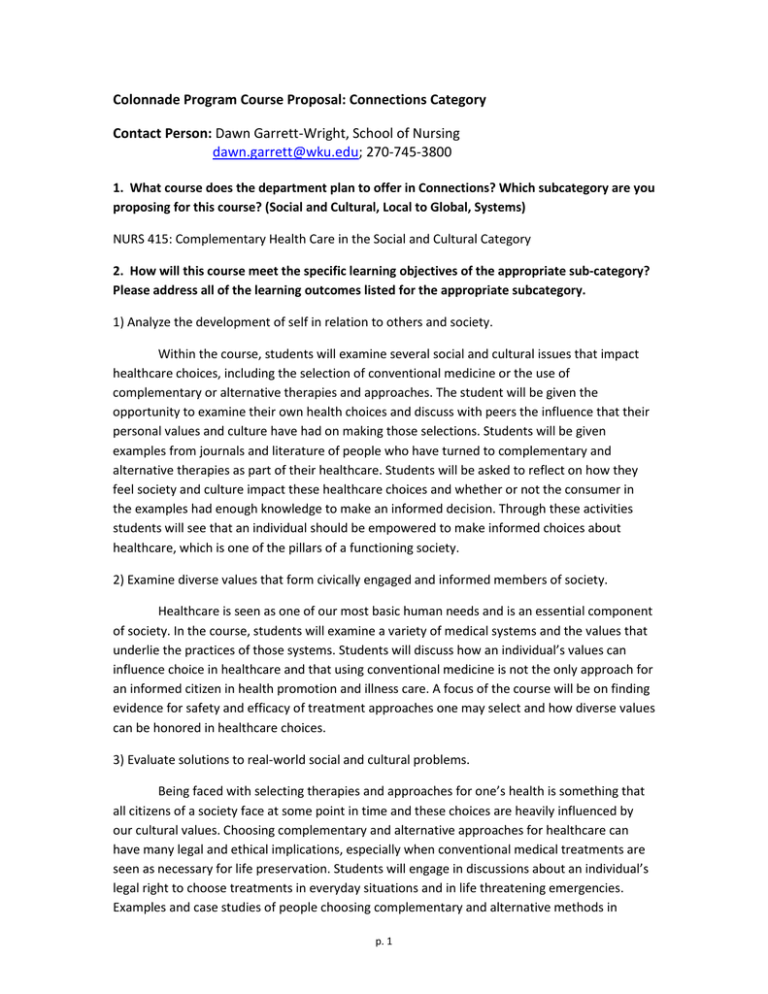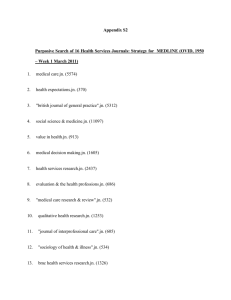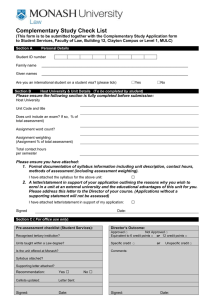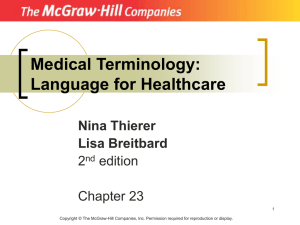Colonnade Program Course Proposal: Connections Category Contact Person: ;
advertisement

Colonnade Program Course Proposal: Connections Category Contact Person: Dawn Garrett-Wright, School of Nursing dawn.garrett@wku.edu; 270-745-3800 1. What course does the department plan to offer in Connections? Which subcategory are you proposing for this course? (Social and Cultural, Local to Global, Systems) NURS 415: Complementary Health Care in the Social and Cultural Category 2. How will this course meet the specific learning objectives of the appropriate sub-category? Please address all of the learning outcomes listed for the appropriate subcategory. 1) Analyze the development of self in relation to others and society. Within the course, students will examine several social and cultural issues that impact healthcare choices, including the selection of conventional medicine or the use of complementary or alternative therapies and approaches. The student will be given the opportunity to examine their own health choices and discuss with peers the influence that their personal values and culture have had on making those selections. Students will be given examples from journals and literature of people who have turned to complementary and alternative therapies as part of their healthcare. Students will be asked to reflect on how they feel society and culture impact these healthcare choices and whether or not the consumer in the examples had enough knowledge to make an informed decision. Through these activities students will see that an individual should be empowered to make informed choices about healthcare, which is one of the pillars of a functioning society. 2) Examine diverse values that form civically engaged and informed members of society. Healthcare is seen as one of our most basic human needs and is an essential component of society. In the course, students will examine a variety of medical systems and the values that underlie the practices of those systems. Students will discuss how an individual’s values can influence choice in healthcare and that using conventional medicine is not the only approach for an informed citizen in health promotion and illness care. A focus of the course will be on finding evidence for safety and efficacy of treatment approaches one may select and how diverse values can be honored in healthcare choices. 3) Evaluate solutions to real-world social and cultural problems. Being faced with selecting therapies and approaches for one’s health is something that all citizens of a society face at some point in time and these choices are heavily influenced by our cultural values. Choosing complementary and alternative approaches for healthcare can have many legal and ethical implications, especially when conventional medical treatments are seen as necessary for life preservation. Students will engage in discussions about an individual’s legal right to choose treatments in everyday situations and in life threatening emergencies. Examples and case studies of people choosing complementary and alternative methods in p. 1 addition to or in lieu of conventional medicine will be examined. Students also investigate and discuss the cost effectiveness and safety of complementary and alternative approaches for common health problems, as well as how to determine the qualifications of practitioners of these therapies. These activities are meant to provide the student with a safe exploration of this topic and skills to determine if approaches and therapies are evidence based and safe for their use in the future. 3. In addition to meeting the posted learning outcomes, how does this course contribute uniquely to the Connections category (i.e., why should this course be in Colonnade)? Discuss in detail. A person’s view of health is embedded within their social and cultural environments. This course allows the student to explore how social and cultural factors impact how one interacts with conventional and alternative healthcare systems and influence health practices. This course contributes uniquely to the Connections category because it offers students an opportunity to learn how to identify credible information on a variety of complementary and alternative health approaches/practices and analyze efficacy, safety and legal issues related to these therapies. At the end of the course a student should be able to make informed choice related to the use of complementary and alternative therapies in their own healthcare. 4. Please identify any prerequisites for this course. NOTE: Any prerequisites MUST be Colonnade Foundations or Explorations courses. There are no prerequisites for this course. Students are required to have taken at least 21 hours of Colonnade Foundations and Explorations courses prior to enrolling in a Connections course. 5. Syllabus statement of learning outcomes for the course. NOTE: In multi-section courses, the same statement of learning outcomes must appear on every section’s syllabus. At the completion of this course, the student will be able to: 1. Identify social and cultural influences on health practices. 2. Discuss the difference between complementary, alternative and integrative approaches to healthcare. 3. Discuss common characteristics of complementary and alternative approaches/therapies. 4. Examine selected complementary and alternative approaches and therapies in terms of efficacy, safety, cost and availability. 5. Utilize credible resources (published research, websites, etc). to differentiate between evidence-based and unproven complementary and alternative healthcare practices and locate qualified providers. 6. Discuss the history, uses of and health implications of selected complementary and alternative therapies including: a. Natural Products i. Herbs/botanicals ii. Vitamins/Minerals iii. Probiotics iv. Other supplements p. 2 b. Mind-body practices i. Acupuncture ii. Massage iii. Mediation/mindfulness iv. Movement therapies v. Relaxation techniques vi. Spinal manipulation (chiropractic) vii. Tai chi/ qi gong viii. Yoga ix. Hypnosis x. Prayer c. Other Traditional Medicine Systems i. Ayurvedic medicine ii. Traditional Chinese Medicine iii. Homeopathy iv. Naturopathy v. Traditional healers 7. Analyze the legal, ethical and cultural implications of utilizing complementary and alternative therapies. 6. Give a brief description of how the department will assess the course beyond student grades for these learning objectives. The School of Nursing BSN Program Curriculum subcommittee will assess the effectiveness of Nursing 415 using the Colonnade Plan Learning Outcomes for the Connections Social and Cultural Sub Category. Nursing 415 will be assessed yearly using the students’ Evidence Based Presentation on a Complementary or Alternative Health modality and their Summative Outcome Paper, which will form their portfolio for the course. Students in Nursing 415 will complete an evidence-based presentation on a selected modality or therapy. This project will require them to explain their personal reason for researching the particular modality/therapy, examine why the modality/therapy is used by certain populations, explain the potential benefits and risks for those who select the modality/therapy, and explore issues such as cost of therapy to individuals or insurance companies and licensure for practitioners of the modality/therapy. Students in this course will also be required to write a 3-5 page summative paper addressing how the course has assisted them in meeting the three student learning outcomes for the social to cultural category in the Connections and how this course has contributed to their education overall. The student will be expected to address specifically why the course was chosen, how the course improved their understanding of the three student learning outcomes for the social and cultural category and how the information from the course will be utilized as they further their education at WKU in their major and how the information can be used in their future lives. The BSN Curriculum subcommittee will randomly select and evaluate student portfolio pieces using a rubric. A holistic rubric will be developed using a 4-point scale. p. 3 4 = outstanding (far exceeds expectations) 3 = good (exceeds expectations) 2 = average (meets expectations) 1 = poor (does not meet basic expectations) The committee will use the following target scores for assessing the course: 70% of work reviewed will score 2 or higher using the holistic rubric 30% of work reviewed will score 3 or higher using the holistic rubric 7. Please discuss how this course will provide a summative learning experience for students in the development of skills in argumentation and use of evidence. Students will be expected to conduct an evidence based independent investigation of a selected complementary or alternative therapy. This will involve searching scholarly journals and websites for evidence about the history, effectiveness, safety, cost, licensure requirements for practitioners and health implications of the selected therapy. The student will then present this information to their peers in an online presentation. The student will be graded on the thoroughness of their presentation and their ability to construct a logical and evidence-based argument on the overall effectiveness of the selected therapy. In addition, students will review and critique each other’s work to determine if their peers are providing evidence based materials on selected modalities and if they have provided a logical and succinct argument for the safety, efficacy and cost effectiveness of the selected therapy. The use of peer critique will allow students additional opportunities to examine evidence on selected modalities, judge the quality of evidence and determine if logical arguments are made. The goal for this course is for the student to be able to construct a logical evidence-based argument and to be able critique the arguments of others in a respectful and knowledgeable fashion. 8. How many sections of this course will your department offer each semester? Two sections of this course will be offered in both summer and winter terms each year. Additional sections will be considered based on the enrollment of in the course. 9. Please attach sample syllabus for the course. PLEASE BE SURE THE PROPOSAL FORM AND THE SYLLABUS ARE IN THE SAME DOCUMENT. p. 4 Western Kentucky University School of Nursing Course Number: Nursing 415 Course Name: Complementary Health Care Course Credit: 3 Credit Hours TIME/SITE: Online-Assignments per Syllabus Outline Faculty: Dawn Garrett-Wright, Ph.D., MSN, CNE MCHC Room 238 Office: 270-745-3800 Email: dawn.garrett@wku.edu Kim Link, MSN, APRN MCHC Room 234 Office: 270- 745-5022 Email: kim.link@wku.edu *Please note that we will not have routine office hours during Winter Term but are available by appointment for face to face meetings. The best way to contact us during Winter Term is via the WKU email address listed above. To ensure prompt replies, please email all questions/comments related to the course to both faculty. One of the faculty members will respond to emails within 24 hours. Thank you and have a good semester. *Syllabus is subject to change. All changes will be posted on Blackboard as soon as possible. p. 5 Course Description: Selected holistic modes of healing will be explored. Focus will be on history, research findings, theoretical basis and legal implications. Course Objectives: At the completion of this course, the student will be able to: 1. Identify social and cultural influences on health practices. 2. Discuss the difference between complementary, alternative and integrative approaches to healthcare. 3. Discuss common characteristics of complementary and alternative approaches/therapies. 4. Examine selected complementary and alternative approaches and therapies in terms of efficacy, safety, cost and availability. 5. Utilize credible resources (published research, websites, etc). to differentiate between evidence-based and unproven complementary and alternative healthcare practices and locate qualified providers. 6. Discuss the history, uses of and health implications of selected complementary and alternative therapies including: a. Natural Products i. Herbs/botanicals ii. Vitamins/Minerals iii. Probiotics iv. Other supplements b. Mind-body practices i. Acupuncture ii. Massage iii. Mediation/mindfulness iv. Movement therapies v. Relaxation techniques vi. Spinal manipulation (chiropractic) vii. Tai chi/ qi gong viii. Yoga ix. Hypnosis x. Prayer c. Other Traditional Medicine Systems i. Ayurvedic medicine ii. Traditional Chinese Medicine iii. Homeopathy iv. Naturopathy v. Traditional healers 7. Analyze the legal, ethical and cultural implications of utilizing complementary and alternative therapies. Instructional Methods: Instructional methods will include, but are not limited to: lecture via talking PowerPoint, class discussion via discussion board feature in blackboard, audio-visuals, National Center for Complementary and Alternative Medicine (NCCAM) learning modules, and assigned readings. This class is conducted online so students must have adequate access to an internet connection and blackboard during the semester. p. 6 Attendance Policy: Students must participate in all course activities to receive a final grade. This policy is in lieu of the traditional attendance policy for face to face courses. See University Attendance Policy in University Catalog. Participation is mandatory for online activities. Participation guidelines will be posted on Blackboard for online discussion and other web-based activities. Students are expected to check Blackboard regularly for course announcements. Required Texts: Alvord, L. A. & Van Pelt, E. C. (1999). The scalpel and the silver bear. New York, NY: Bantam. American Psychological Association (2009). Publication manual of the American Psychological Association (6th Ed.). Washington, D.C.: American Psychological Association. - use 2nd printing or higher. Fadiman, A. (2012). The spirit catches you and you fall down: A Hmong child, her American doctors, and the collision of two cultures. New York, NY: Farrar, Straus & Giroux. Micozzi, M. (2010). Fundamentals of complementary and alternative medicine (4th Ed.). St. Louis, MO: Saunders. . p. 7 Evaluation Methods: Successful completion of each NCCAM module (15 pts. /module) Poster Presentation on Herb/Nutritional Supplement Evidence Based Presentation on CAM Modality Discussion boards (20 points/discussion board) Final Exam Summative Outcome Paper 60 points 100 points 100 points 100 points 100 points 100 points 560points Grading Scale: 91 – 100% 84 – 90% 77 – 84% 68 – 76% Below 68% = = = = = A B C D F Points and grade percentages in this course are not rounded. Course Info: The syllabus, class schedule, examination scores and other information will be posted on Blackboard. You can reach the site by addressing the web at http://ecourses.wku.edu and following the directions on the login page. All documents on Blackboard may be printed. Western Kentucky University provides students e-mail addresses through the university in order to facilitate communication with faculty and peers. We will use the university generated addresses to correspond with students in this course; therefore, students are expected to check WKU email messages at regular, frequent intervals. Faculty Responsibilities: • • • • • • • • Challenge students to grow intellectually. Prepare presentations, assignments, and activities that facilitate learning. Interact with students as adult learners, respecting the knowledge that the student brings to coursework through previous professional and life experiences. Respond to student questions in a timely manner. Provide a grading rubric for assignments and grade assignments using the provided rubric. Return assignments, with feedback, in a timely manner. Assist in problem-solving technology issues that arise through the use of Blackboard. Faculty may change the class schedule and assignments at any time, due to extenuating circumstances. Changes will be announced, via Blackboard, a week in advance if at all possible. p. 8 Student Responsibilities: Students are expected to follow all policies as printed in the current Western Kentucky University Department of Nursing Student Handbook. Students are responsible for completing all assignments by the designated due date. Students are expected to work independently and submit assignments on the date and time due. Faculty is aware that extenuating circumstances may require extension of due dates for assignments. Such requests should be made to the faculty prior to the established due date and are granted at the faculty’s discretion. Late assignments will not be accepted more than one week after the deadline. Discussion boards posting time periods will not be extended as this is a collaborative activity. Written work: 1. Must be submitted by the assigned time on the scheduled date or a 20% reduction in the grade for the assignment will result. If you need an extension, you must contact the faculty at least 24 hours before the due date/time. 2. Must conform to the format specified in: American Psychological Association (2009). Publication manual of the American Psychological Association (6th Ed.). Washington, D.C.: American Psychological Association. *Note- second printing or higher. NCCAM Modules: All students will complete 4 video lectures available at the National Center for Complementary and Alternative Medicine website: http://nccam.nih.gov/videolectures/ Students must complete the post-test with a passing score (77%), save a copy of the completion certificate for each module, and submit all certificates the date and time listed in the syllabus. A link to the NCCAM website will also be available on Blackboard. Other: Students are expected to read the assigned material. Accommodations: Students who require accommodations will notify The Student Accessibility Resource Center located in DSU 1074 on the 1st floor next door to the Study Room. (270) 745-5004 • sarc@wku.edu • wku.edu/sarc Per university policy, please DO NOT request accommodations directly from the professor or instructor without a letter of accommodation from the Student Accessibility Resource Center. Academic Honesty: WKU students are expected to demonstrate the highest standard of honesty in all aspects of their academic work and college life. Without intellectual integrity there can be no genuine learning. Academic dishonesty represents a direct attack on this integrity. In taking test and examinations, completing homework writing papers, and using information technology, students are expected to perform honestly. The WKU Nursing Student handbook (accessed through the WKU Department of Nursing webpage) delineates the academic honesty policy. Discussion Board Assignments: Discussion board assignments are posted in the topic outline at the end of the syllabus. You must post during the assigned times. The grading rubric for the discussion boards is provided in the syllabus. There will be no exceptions to the grading criteria. Faculty member may or may not participate in the discussion. p. 9 Discussion Board Guideline and Rubric Criteria Mechanics of posting Participation in posting Content of posting Critical thinking evidenced by posting 5 4 Complete sentences, well organized, grammatically correct, and free of spelling errors. At least 4 or more postings welldistributed throughout period and adheres to all general guidelines. Cited references to textbooks and articles in APA format. Complete sentences, well organized but 2 or less spelling/grammar errors, 1 guideline not adhered to, at least 3 postings distributed throughout period Complete sentences, comprehensible, organization should be improved to present a more coherent argument, has 3 or more grammar/spelling errors. 2-3 guidelines not adhered to. 3 Provides comments and new information in a regular manner. Interacts with class participants. Responds to questions and statements from course faculty/discussion leaders 100% of the time. The first posting was submitted within 48 hours of the opening of the discussion forum. Postings reveal a solid understanding of the topic as evidenced by thoughtful responses and questions. Postings indicate clearly that readings were completed, understood and incorporated into responses. Provides comments and some new information in a fairly regular manner. Interacts with few course participants. Responds to questions and statements from course faculty/discussion leaders at least 75% of the time Sporadically provides comments and some new information. Interacts with only 1-2 class participants. Posts only response to questions/no interaction or responds to 50% of questions posted or responses incompletely. Postings reveal an adequate understanding of topic but are superficial. Postings indicate readings were understood and incorporated into responses. Contributes new information which stimulates discussion or provides new insight to discussion. Agree or disagree with existing discussion and provided limited justification/explanation. Exhibits some good insights and understanding. Postings reveal a limited understanding or readings or are limited only to what information is provided in faculty or group member postings. Postings have questionable relationship to reading material and/or faculty questions posted to guide discussion. Agreed or disagreed with existing discussion but provided no justification/explanation. Offers no insights, questions or stimulation for discussion. p. 10 2 Poor sentence structure, inadequate organization, several grammar/spelling errors result in unclear meaning in postings, postings not evenly distributed, 4 or more guidelines not adhered to. Did not include references when needed and/or references were not in correct APA format. Provides minimal comments “I agree…” “I disagree..” And offers no evidence of reason for response. Answers no questions posted by faculty or discussion leaders or answers with brief incomplete response. The first posting was submitted during the last 48 hours of the discussion forum. Postings unrelated to discussion topics. No evidence that readings were completed, understood or used as a basis for discussion. Posting inappropriate to discussion Provided no evidence of critical analysis, evaluation or insight. Poster Guideline and Scoring Poster will present information relating to a selected (and approved) CAM Modality. Posters must be prepared utilizing PowerPoint poster templates (an example may be found at http://www.postersession.com/) No late submissions will be accepted. Copies of reference should be included as an attachment, not part of the poster. . Grading: Criterion Points Content: 60 Define the modality, describe the history of its use, including traditional and modern day use (if applicable) Cost/availability What types of certifications/license are required (if any) to use the modality in practice? Efficacy Side effects Drug-drug and/or drug-food interactions Benefits of treatment with modality Contraindications *Students must include health implications from peer reviewed research. Visuals: 20 Format Readability (Poster = from 3 feet) Aesthetics Grammatical correctness Spelling References: APA format per 6th edition. Must include in text citation on the poster. Minimum of 5 references, (excluding any book required for this course). *Students must include scholarly, research-based sources. Plagiarism is not acceptable on posters and will result in a grade of “0” on the project and failure of the course. TOTAL p. 11 20 100 Presentation Guidelines and Scoring Criteria Content: - Identify/Define CAM modality - Describe why selected - Provide brief background - Summarize key content learned regarding CAM modality including: (Implementation of CAM modality (who utilizes it? How much does it cost? What types of certifications/license does it require?) - Identify critical nursing implications such as: Benefits to treatment, Any Negatives?, Contraindications? - Evidence based practice issues- what research is available on the therapy/approach and what is the quality of available research? - Application to current and future healthcare practice - Include references in last slide Audio-visuals: - Use PowerPoint and at least one other tool to assist audience (handout, photograph, brochure example) May be scanned in. - AV choice clear and beneficial to audience learning. - Don’t read the slides. Verbal communication should expand on knowledge presented in slides - Slides should be readable, concise and uncluttered. - Audio portion should be audible (please check as you record). Adherence to time (Limits: minimum 10 min - maximum 15 min.) References: - APA format- please cite within the slides. References to be included at the end. - Minimum of 5-7 references, (excluding any book required for this course) - Assigned one peer reviewed, scholarly journal article for peers for reference on your topic *Students must include scholarly, research-based sources. TOTAL p. 12 Points possible 50 20 10 20 100 p. 13



